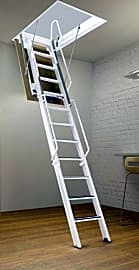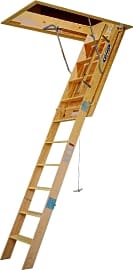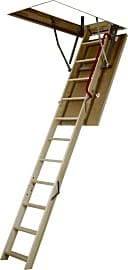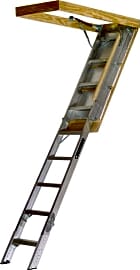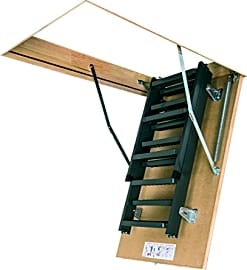The 7 Best Attic Ladders

This wiki has been updated 32 times since it was first published in February of 2017. The attic is one of the most useful storage spaces in the home -- as long as you can get into it without too much hassle. Any of these ladders will help you do just that, since they conveniently pull down to provide access and fold back up compactly when you’re done. We’ve ranked them based on factors like ease of use, weight capacity, quality of materials, sizing options, and price. When users buy our independently chosen editorial picks, we may earn commissions to help fund the Wiki.
Editor's Notes
August 08, 2020:
Joining the list today is a Werner WH3008, a wooden model with a compact profile that’s easy to open and fold back up. It’s made with safety in mind, with each of the nine steps being rodded for strength and durability. A counter-balance mechanism effectively eliminates sag and springiness. Its full wrap-around hinge helps eliminate heat loss. It boasts a conveniently compact design, and helpful setup videos are available online. After some consideration, we kept the Fakro 860432 Steel Scissor in its top spot today, which features a 300-pound weight capacity and works with ceilings of up to 10 feet. This one boasts a sleek steel design and includes a set of handrails to assist you in your climb. For another steel model but one with a folding design, look to the Fakro 66869, which can support weight of up to 350 pounds and comes with textured steps for safety. Note that the handrail does need to be purchased separately for this model.
If you prefer the light weight and affordability of aluminum, look to the Louisville Ladder AA2510, which offers a relatively large clearance that makes it easy to carry large items into and out of the attic. This model provides excellent insulation to prevent the transfer of heat or cold air. It comes with temporary hanging strips and all of the required installation hardware. For a wooden model from the same well-known brand, consider the Louisville Ladder S305P, which boasts a smooth, attractive finish. It’s got convenient adjustable spring tension and hinges that effectively limit side-to-side motion. Included is an installation kit with hanging straps, plywood shims, and nails.
Many of the attic ladders on our list conveniently come as preassembled kits, which helps ensure you’ll have everything you need on installation day. Factors to consider when installing your ladder include whether your attic floor and roof are framed with trusses or with individual rafters and joists. The former cannot be cut or altered, whereas the latter can be reorganized, as needed, to make way for your new ladder. If you’re also in the market for other types of ladders, refer to our lists of best telescoping ladders, which are often compact and easy to transport, as well as best step ladders, which prove useful around the house for painting walls or reaching items on high shelves.
June 19, 2019:
When you have an attic with limited access, a handy pull-down ladder will help you get up and down from your storage space, without having to set aside a chunk of your day each time you need to access your stored items. Selections come in materials like aluminum, wood, and steel, and each is rated to support a set maximum weight. These factors are important to consider when you’re choosing the right one for your home. Additional amenities that come with some models include handrails for safety and comfort, and an insulated door that will seal tightly to help save on your heating and cooling bills.
Joining the selection is the Fakro 66802, which is great for those who prefer a sturdy wooden model. It comes with a metal handrail you can choose to install on either side, for safety. When it’s time to open it, just insert the rod into the latch to pull down the door smoothly. It’ll help keep your utility costs down, thanks to its thick rubber gasket insulation. Another newcomer from a respected name in the industry is the Louisville Ladder S305P, which also features an attractive wooden finish. It’s relatively easy to set up, thanks to the manufacturer’s proprietary hanging strap system, which is included with your purchase. You’ll climb this model with confidence, thanks to its step depth of 5.375 inches, as well as metal hinges that limit side-to-side motion.
Another new addition is the Italian-manufactured Rainbow F2260-12, which is quite an investment but comes with an impressive list of specs – not the least of which includes a high weight-bearing capacity of 570 pounds. It’s made with safeguards such as four one-piece handles on the sides and two on top. The floor bumpers keep it from moving, while the strips on each stair help to keep your feet firmly in place.
Leaving the list are the Louisville S224P, due to its flimsy door that might not survive moderate use, as well as the OxGord Heavy Duty Extendable and the Werner AA1510CA, both due to some reported quality issues.
Be sure to install and use your attic ladder responsibly. Hiring a professional carpenter for installation will ensure it’s setup properly and safe to climb. The manufacturer’s instructions should be followed carefully for assembly and installation. And as a rule, always inspect any ladder thoroughly for problems before climbing it.
Special Honors
Precision Ladders Super Simplex This commercial-grade, aluminum folding stairway is suitable for ceiling heights up to 12 feet in commercial applications and more than 13 feet in residential ones. What makes it unique is its frame features built-in treads that are custom made to the exact distance from the ceiling to the floor above, thereby accommodating drop ceilings. It’s rated to hold up to 500 pounds and is made in the U.S.A. precisionladders.com
Werner AH2512 This universal folding-style attic ladder is lightweight, yet can bear the weight of up to 375 pounds. Its strut design eliminates the need for springs and also provides for a wide access opening. It opens and closes smoothly and features user-friendly wide steps that are slip resistant. It features non-marring feet and is available for either standard or extra-wide openings. wernerco.com
Reaching New Heights
Unlike their wood counterparts, they also have the ability to telescope.
When it comes to accessing high places safely and easily, having a staircase or ladder at your disposal is something you might take for granted, simply because you're so used to having a supportive object like that around to help make certain tasks easier to accomplish. Despite its ordinary presence, a ladder's applications, types, and range of versatility are anything but ordinary when you think about them. Ladders serve a multitude of purposes, from helping the construction worker in precarious situations and facilitating the saving of lives for professional firefighters to simplifying that trip up to the attic. It is this latter type of ladder that we'll be focusing on here.
The attic ladder is a retractable piece of hardware that attaches to the ceiling of the story directly beneath an attic within a home or building. It is considered both an inexpensive and space-saving alternative to constructing a fixed staircase in such a location. Attic ladders are usually known for their wide support rungs, steep slopes, and drawstrings, which make it easy to manually extend them.
Wood, steel, and aluminum are among the most common construction materials used for most attic ladders. While wooden attic ladders are relatively inexpensive and sturdy, they're also quite sensitive to temperature changes and moisture accumulation. The natural defects in wood can also make the ladder more susceptible to degradation over time. Aluminum and steel attic ladders are lightweight and rust-resistant, and they offer superior longevity. Unlike their wood counterparts, they also have the ability to telescope.
For most residential installations, attic ladders are available in folding, telescoping, and scissor-style designs. The folding attic ladder consists of three or four individual sections stacked on top of one another when stored away. When an attic hatch is opened, the ladder must be unfolded down to the floor. This can be done either automatically or manually, depending on your preference. Each section then braces against one another in order to prevent the ladder from collapsing under a person's weight.
By contrast, the telescopic attic ladder is made up of small, connected sections that form a single long ladder for ascending and descending. Rather than folding away, the telescopic attic ladder slides into itself via these connected sections, making it ideal for installation in areas with high ceilings or limited landing space.
The scissor attic ladder also folds, but in a different manner than the conventional folding type. When thinking of a scissor attic ladder, imagine the anatomy of an accordion for a moment. The bellows at the center of the accordion act as the instrument's "lungs", which help to push air through individual reed blocks, yet it's the bellows' ability to expand and contract that provide a visual similarity to how a scissor-style attic ladder operates. The individual steps of a scissor ladder expand and contract in a similar fashion. However, that's really where the similarities end, and I wouldn't recommend playing an accordion while ascending an attic ladder, as there are probably safer places to get your polka on. For one thing, hauling your accordion up to the attic by means of a ladder might provide a quiet place to play just in case your family doesn't appreciate its unique sound as much as you do.
Keeping Practical Considerations In Mind
One of the first considerations to make when installing an attic ladder is the amount of available floor and roof space. If you decide to go with a folding option, you'll need around five-and-a-half feet of floor space so the ladder can touch down easily, while giving you plenty of room to safely mount and dismount as you climb up and down.
Full-size attic ladders usually require an opening around 22.5 by 54 inches.
Next, measure the opening in the ceiling needed to comfortably access your attic. Keep in mind that you'll need room to carry things up and down. Full-size attic ladders usually require an opening around 22.5 by 54 inches. If you live in a home with really tight spaces, a telescoping or scissor-style ladder is a great option, many of which are equipped with built-in handrails.
Regardless of whether you install a folding or telescoping option, they must be secured to the perimeter of the attic opening (or to the joists). Springs and struts may also be used to ensure strength and stability, while a solid joist system must be in place prior to installation.
Your geography and climate are good indicators of the type of material you should consider. Since wood is more sensitive to sudden changes in temperature and moisture, that's all the more reason to consider either a steel or aluminum option when living in areas with extreme seasons.
A Brief History Of Attic Ladders
While there is no definitive date marking the beginning of the ladder's existence, the earliest reference to the invention dates back over 10,000 years to a Mesolithic rock painting found in the Spider Caves of Valencia, Spain, which depicted a hunter-gatherer who was believed to have been collecting wild honey from a beehive. The figure in the painting looks to be ascending a flexible ladder made from some type of grass.
The figure in the painting looks to be ascending a flexible ladder made from some type of grass.
The roots of a ladder's more practical design can also be traced back to ancient Egyptian and Hebrew cultures responsible for developing and perfecting the technology.
The development of the conventional step ladder occurred toward the latter part of the 17th century and is primarily attributed to master carpenter and inventor John H. Balsley in 1862. Although step ladders existed before this time, Balsley's major contribution was in regard to the safety of the ladder by replacing round rungs with flat steps, offering greater jobsite stability for workers who had to climb up and down.
Wood remained the most common construction material for most step and attic ladders up until the 19th century, followed by the aluminum and steel models found in many homes today. Modern attic ladders are lightweight, durable, and even fire-resistant to ensure superior safety in any home.


